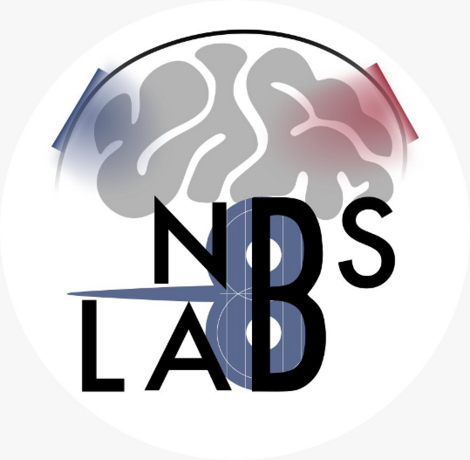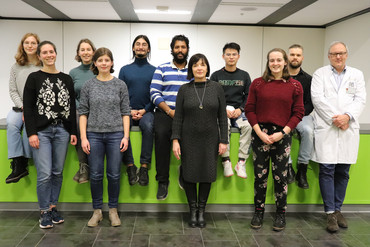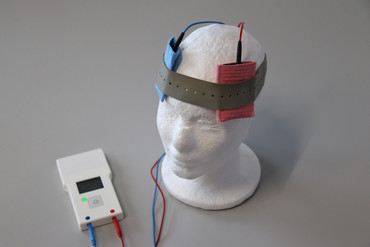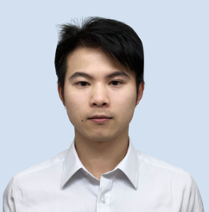Transcranial Magnetic and Electric Stimulation Teaching Course
The new dates for the ESBS training course are November 6–8, 2025. Further information will be provided soon.
Noninvasive Brain Stimulation Lab (NBS-Lab)
Prof. Dr. Andrea Antal’s research group investigates the effects of non-invasive brain stimulation. This includes the application of transcranial alternating and direct stimulation, as well as transcranial magnetic stimulation.
With this methodology a range of diseases which originate in the brain can be treated, e.g.: depression, dementia and fibromyalgia. For the treatment small electrical currents are used to target specific brain areas or related neuronal networks. The stimulation alters the neuronal activity and aims at facilitation or inhibition of brain area.

Research Group

The team of Prof. Dr. Andrea Antal comprises three postdoctoral researchers, two PhD students, a visiting scientist, two student research assistants as well as two MSc student, working to unravel important questions in the field of brain stimulation in the clinic. In addition, more than ten medical students are being supervised by Prof. Antal for their doctoral theses as part of the group.
Research focus
Transcranial direct current stimulation

The transcranial direct current stimulation (tDCS) is a non-invasive brain stimulation technique which employs low electrical currents.
By placing at least two electrodes on the head, the patient receives either an anodal or cathodal stimulation which, repsectively, lead to an increase or decrease of the cortical excitability (tDCS Database: http://tdcsdatabase.com/; Developed by the research group in cooperation with the research group surrounding Prof. Marom Bikson).
Already a short stimulation duration (~10 min) can have positive effects. These effects are due to electrophysiological changes in the neuronal cell membrane.
Higher performance in various cognitive areas (e.g. memory, attention, reaction time) can be achieved through the stimulation. Depending on the stimulation protocol these effects can even persist after the simulation has been discontinued.
Currently, we are researching the efficacy of tDCS in cancer-related pain and its combined effect with task training to improve dual task ability in the healthy elderly.
Transcranial alternating current stimulation

The transcranial alternating current stimulation (tACS) differs from tDCS as it applies a low-intensity sinusoidal electrical current to the brain. This occurs at a chosen frequency to interact with the brain’s cortical oscillations which can change the excitability or activity in specific brain areas.
Both single-frequency and cross-frequency tACS paradigms exist. The latter is based on the superposition of a high-frequency signal with a low-frequency signal using phase-amplitude coupling.
Like tDCS, tACS offers many opportunities to be applied. Currently, the NBS lab is applying tACS to older adults to improve their cognitive abilities and prevent neurocognitive disorders such as mild cognitive impairment, a precursor to dementia. We are also testing the efficacy of tACS to reduce pain in patients with cancer as well as to improve the visual functioning of patients with significant optic atrophy caused by glaucoma.
Current studies at the NBS lab
Cognitive aging and Heart-brain interaction
Description:
This study represents a novel attempt to enhance cognitive aging by integrating the emerging field of heart-brain interaction. Heart rate variability (HRV) serves as a crucial index of heart-brain interaction and autonomic nervous system dynamics. Previous research has established a positive association between higher HRV and enhanced functional connectivity in the medial prefrontal cortex and amygdala, accompanied by improved cognitive performance. Non-invasive brain stimulation, particularly transcranial magnetic stimulation (TMS), holds significant potential for improving cognitive function in individuals with cognitive impairment. Recent studies have revealed that applying repetitive TMS (rTMS) over the frontal-vagal network can enhance HRV. Therefore, our aim is to enhance cognitive performance in subjects with cognitive impairment and normal aging through frontal-vagal rTMS. Furthermore, we aim to explore the underlying mechanisms of heart-brain interaction during aging using brain imaging techniques.
- Responsible for the study: Ms. Xue Guo
- E-Mail: : Xue.Guo(at)med.uni-goettingen.de
- Collaborating partners:
- Prof. Melanie Wilke, Dept. of Cognitive Neurology, University Medical Center Göttingen
NeuroVR-Plus: Adaptive VR training & transcranial electrical stimulation to improve cognition in older adults
(BMBF: Miteinander durch Innovation 16SV9248)
Based on the results of a previous study (Means to improve cognition in older adults with or without cognitive impairment - from training to non-invasive brain stimulation, see below), this project aims to combine tES with cognitive training to improve the cognitive abilities of older people. For this purpose, a cognitive training in virtual reality is developed in this study, which is specially adapted to the needs of older adults. In addition, this training is adaptively adjusted to the individual cognitive strain, which is measured by means of eye tracking during the VR application, in order to achieve an optimal learning effect. The exact stimulation location is also individually adapted to the anatomy of the individual (using MRI images and simulations of the propagation of the electric field strength). Various cognitive parameters (memory, executive functions) and electrophysiological data (EEG) are examined. The aim is to achieve a lasting improvement in the cognition of older people.
The project is led by Irina Shiyanov, CEO of the VRalive UG, a start-up company specialized in VR technology.
- Responsible for the study:Dr. Lukas Diedrich (PostDoc)
- Collaborating company: VRalive UG Braunschweig (CEO Irina Shiyanov)
- Link to project: https://www.interaktive-technologien.de/projekte/neurovr-plus
Differential tDCS and tACS effects on motor and cognitive performance in the healthy elderly.
With aging, dual task (DT) ability declines and is more cognitively demanding than single tasks. It has been identified that attention as well as execution factors are the most critical predictors of DT performance, and aging-induced decline in these factors is closely related to the impaired cognition in the elderly. Previous studies addressed the rapidly declining DT performance as a predictor of neurodegenerative disease including Parkinson’s disease and Alzheimer’s disease. The purpose of this study is to explore the effects of theta tACS and anodal tDCS on gait and cognitive performance, we are implementing a neuromodulation-based method to improve dual-task performance in the healthy elderly.
- Responsible for the study: Mr. Yong Jiang
- Contact for interested participants:
- Tel: 0551- 3968474
- Contact hours: Montag & Mittwoch,13.00-15.00 Uhr
- E-mail address: neurologie.multitasking(at)med.uni-goettingen.de
Central pain modulation biomarkers and their role in the home-based brain stimulation to treat refractory cancer pain
PAINLESS: Home-based transcranial electrical stimulation in for pain relief in patients with cancer.
(Europe Horizon: HORIZON-HLTH-2021-DISEASE-04-01; PAINLESS)
A new home-based approach to manage pain in patients with cancer is being investigated in a multicenter clinical trial using transcranial electrical stimulation (tDCS and tACS). The study aims to test the therapeutic efficacy of these methods (15-days of daily tES) in pain relief and reduction of associated symptoms in patients with cancer. The mechanistic impact of the stimulation interventions will also be assessed via quantitative sensory testing and EEG. Moreover, we will compare how cancer patients with pain and without pain differ in terms of pain processing using central biomarkers of pain. Having a home-based intervention improves the accessibility of the study to patients living far away as well as reduces the burden of daily travels to the clinic.
This study is part of the EU research and innovation funding project Europe Horizon. In total, ten different countries cooperate on this study.
- Responsible for the study: Perianen Ramasawmy
- Collaborating partners:
- Projected led by Prof. Maria Teresa Carrilla-de-la-Peña, University Santiago de Compostela.
- Link to project: https://palliativeprojects.eu/painless/home/about-painless/
- Contact for interested participants:
- E-mail address: neurologie.painless(at)med.uni-goettingen.de
- Tel: 0551- 3968474
- Contact hours: Tuesday & Thursday, 10.00-12.00 Uhr
FIBRO-ACCT: Home-based accelerated tDCS in fibromyalgia
Fibromyalgia is a chronic pain condition, characterized by persistent widespread pain across the body and is associated with sleep impairment, psychological distress, and chronic fatigue, among other symptoms. Previous studies have shown the therapeutic benefits of home-based tDCS in fibromyalgia. With the goal of obtaining faster and larger pain relief, accelerated stimulation protocols have been developed.
In the FIBRO-ACCT clinical trial, we will recruit women diagnosed with fibromyalgia to investigate the effects of accelerated tDCS home stimulation on pain factors, quality of life and other fibromyalgia-associated symptoms, and other fibromyalgia-associated symptoms. Other goals of the study are to predict the outcome of tDCS by assessing negative life experiences and attachment insecurity in childhood and to better understand differences in cortical excitability and study potential biopsychosocial factors mediating the effects of the stimulation.
Responsible for the study: Dr. Perianen Ramasawmy
Collaborating partners: Dr. Anne Kästner and Prof. Dr. Frank Petzke, Pain Clinic, Department of Anesthesiology, UMG
Contact for interested participants:
E-mail address: neurologie.nbs-fibro@med.uni-goettingen.de
Tel: 0551- 3968474
Contact hours: Tuesdays 09:00 to 12:00 and Wednesdays 14:00-17:00
Transorbital electrical stimulation to improve the visual functioning of patients with significant optic atrophy caused by primary open angle-glaucoma
Glaucoma is one of the most common causes of blindness and affects more than 70 million people worldwide. It is characterized by the loss of retinal ganglion cells associated with a progressive optic neuropathy resulting in an impairment of visual function, e.g. visual field loss.
To date, glaucoma can only be treated by lowering intraocular pressure to slow down the progressive course of the disease. Indeed, the underlying mechanisms are not targeted by the current treatment strategies, and vision loss, once present, cannot be restored. Therefore, new treatment options are required to improve vision as the nerve fibre loss, once it is manifest, is not reversible, neither by medication nor by surgical approach.
In several small trials and one multicenter study, tACS was performed daily in an attempt to re-activate residual vision in optic neuropathy using frequencies ranging from theta to high beta via electrodes placed near the eye. The treatment increased light detection performance and reduced patient-reported, vision-related daily living impairments that correlated moderately with visual field gains. However, the level of evidence of this method is still poor, and further trials are necessary. In the opinion of German ophthalmological societies (i.e.DOG and BVA), the applied methods were not satisfactory (e.g. non-established perimetry methods, lack of the measurements of eye movements, inhomogeneous patient populations, and incorrectly defined trial endpoints (http://www.dog.org).
Our multi-center double-blind sham-controlled study aims to clarify the contradictory data in this field and uses established and well-defined visual-field parameters. The novel aspects of this trial are the individual current flow modeling based on the visual impairment and the application of stimulation protocol with predefined electrode montage and fixation of a target during the experiment.
- Responsible for the study in the Neurology: Prof. Andrea Antal
- Responsible for the study in the Ophthalmology: Prof. M. Schittkowski & Dr. J. Pohlner, University Medical Center Göttingen
Breathing and TMS
We have already successfully validated and established the method of noninvasively deriving motor evoked potentials of the diaphragm (diMEPs) by means of TMS in our institution (Chakalov et al., 2022). TMS allows noninvasive and non-volitional inspection of the integrity of the corticospinal pathway to breathing muscles. Therefore, a currently ongoing project aims to use this method for diagnosing diaphragm dysfunction in ventilated critically ill patients in the Intensive Care Unit at UMG.
- Responsible for the study: Dr. Ivan Chakalov
- Collaborating partners: Dr. Caspar Stephani, Dept. of Anesthesiology, University Medical Center Göttingen
- Link to relevant publications: The role of the TMS parameters for activation of the corticospinal pathway to the diaphragm
Completed studies of the NBS Lab
Means to improve cognition in older adults with or without cognitive impairment - from training to non-invasive brain.
This study aimed to investigate the effects of combined transcranial electrical stimulation and computerized cognitive training to improve cognitive abilities in older adults with or without cognitive impairment. Mild cognitive impairment is associated with an increased risk of developing dementia, which underscores the urgency for early diagnosis and the development of innovative treatment modalities.
- Responsible for the study: Dr.Lukas Diedrich
- Collaborating partners: Prof. Michal Lavidor, Department of Psychology, Bar Illan University Israel
- Links to publications:
- Boosting working memory in the elderly: driving prefrontal theta–gamma coupling via repeated neuromodulation
- Prefrontal theta—gamma transcranial alternating current stimulation improves non-declarative visuomotor learning in older adults
- New Methods, Old Brains—A Systematic Review on the Effects of tDCS on the Cognition of Elderly People
- Beyond social engagement: cognitive training leads to greater cognitive improvement in older adults
Stimulating the mindful brain- pairing tDCS and mindfulness meditation in fibromyalgia.
The study aimed to test the therapeutic and mechanistic effects of combining mindfulness meditation and transcranial direct current stimulation in fibromyalgia patients who received a brief 4-week mindfulness training. Fibromyalgia is a chronic pain condition characterized by widespread and persistent musculoskeletal pain. This condition is also associated with sleep, cognitive, mood, and psychological impairments as well as chronic fatigue. Mindfulness meditation is a cognitive training technique in which the practitioner focuses on awareness of sensations, emotions and thoughts without pursuing them further. We investigated the underlying mechanisms in the cortex of our novel combination method using transcranial magnetic stimulation and EEG.
- Responsible for the study: Dr. Perianen Ramasawmy
- Collaborating partners: Prof. Frank Petzke, Department of Anesthesiology, University Medical Center Göttingen & Dr. Olga Lucia Gamboa Arana, EQness, Sydney, Australia
- Links to publications:
- Pain reduction in fibromyalgia syndrome through pairing transcranial direct current stimulation and mindfulness meditation: A randomized, double-blinded, sham-controlled pilot clinical trial
- Stimulated brains and meditative minds: A systematic review on combining low intensity transcranial electrical stimulation and meditation in humans
Brain Stimulation Reconsidered - Participative Development of a Code of Conduct for the European Union
Background:
Non-invasive brain stimulation methods such as transcranial direct current stimulation (tDCS) or transcranial magnetic stimulation (TMS) have received a great deal of attention in recent years in research and for the treatment of mental illnesses. In addition, they are being used more and more frequently. As a result, numerous safety guidelines have been established to ensure the safe use of these methods in research and clinical treatment. However, there are ethical questions for researchers and practitioners in this context that are difficult to answer; for example:
Where is the line between treatment and performance enhancement?
How should vulnerable groups such as the elderly or children be treated?
Should brain stimulation be used for individuals who are unable to consent due to illness?
What might be the impact of research results outside of clinical research and treatment on the open market?
In addition, more and more devices and instructions for the use of the underlying technology have been developed in the recent past. These are intended to be used for non-clinical application purposes such as cognitive performance enhancement and their effectiveness is often not scientifically proven.
Aim:
The project aimed to develop a Code of Conduct for the use and research of non-invasive brain stimulation for the European Union together with representatives from society, science, politics and industry. This code of conduct should enable researchers to reflect on their own research from an ethical point of view and support legislative bodies in developing a long-term legal framework for the use and marketing of non-invasive brain stimulation.
Procedure:
After a comprehensive literature review, the perspectives of everyday experts was collected in participatory workshops including different stakeholders, which will then be discussed with experts from different relevant disciplines. On the basis of these participatory results, a code of conduct was developed that can take the different perspectives into account.
https://www.cerri.iao.fraunhofer.de/de/projekte/stimcode.html
- Responsible for the study: Prof. Andrea Antal and Dr. Perianen Ramasawmy
- Collaborating partners:Project led byDr. Moritz Julian Maier, Fraunhofer IAO
- Link to publications:
Temporally interfering alternating current stimulation in the muscles of healthy individuals
Although modulatory effects of temporal interference stimulation (TIS) have been demonstrated in the brain of animals and in human models, the strategy is not yet proved in living humans. In this study, we are trying to build evidence for the concept first through simple protocols testing its elementary mechanisms in the muscle. After completion of analysis on healthy individuals, patients affected with different neuromuscular diseases are included. Compliance in the use of the method in patients with a pre-damaged neuromuscular unit are evaluated. In addition, differences in response of individuals with neuropathic or myopathic disease are compared to healthy controls.
- Responsible for the study: Mr. Simon Gronemann & Mr. Krisztian Iszak
- Collaborating partners: Dr. Jana Zschüntzsch, Dept. of Neurology, University Medical Center Göttingen.
- Link to publications:
Leading researcher

Kontaktinformationen
- Telefon: +49 551 398461
- E-Mail-Adresse: aantal(at)gwdg.de
Prof. Antal is currently vice-president of the European Society of Brain Stimulation (ESBS) (https://www.brain-stimulation.eu/members/). As a member of a committee of the International Federation of Clinical Neurophysiology (IFCN) she offered recommendations on the training of the practice of non-invasive brain stimulation.
Team
Kontaktinformationen
- Telefon: +49 551 398457
- E-Mail-Adresse: ivan.chakalov(at)med.uni-goettingen.de
Kontaktinformationen
- Telefon: +49 551 3964838
- E-Mail-Adresse: lukas.diedrich(at)med.uni-goettingen.de
Dr. Diedrich holds a Bachelor's and Master's degree in Biomedical Engineering from the Technical University of Ilmenau. He completed his Ph.D. (Systems Neuroscience; University of Göttingen) in the NBS Lab running a two-center clinical trial combining transcranial electrical stimulation and cognitive training to improve cognition in the elderly (see above).
He is currently working as a postdoctoral researcher in the NBS lab on the NeuroVR-Plus project.
Kontaktinformationen
- E-Mail-Adresse: perianen.ramasawmy(at)med.uni-goettingen.de
Dr. Ramasawmy is from the paradisiac island of Mauritius and completed his Bachelor’s degree in Neurosciences at the University of Bristol in the UK. He holds a Master’s degree in Neurosciences at the University of Göttingen. He completed his Ph.D. (IMPRS Neurosciences; University of Göttingen) in the NBS Lab running a randomised clinical trial combining mindfulness meditation and tDCS in patients with fibromyalgia (see Completed Studies).
He is currently working as a postdoctoral researcher in the NBS Lab on the PAINLESS project.
Kontaktinformationen
- Telefon: +49 551 3967636
- E-Mail-Adresse: xue.guo(at)med.uni-goettingen.de
Ms. Guo has a robust background of psychology. Her early research explored how transcranial alternating current stimulation (tACS) impacts visual working memory.
Now, she is conducting research on frontal-vagal rTMS and its potential to enhance fronta-vagal rTMS cognitive performance in elderly adults.

Kontaktinformationen
- E-Mail-Adresse: yong.jiang(at)med.uni-goettingen.de
I’m Jiang Yong. I’m from China and I’m doing my PhD at the UMG. I have studied kinesiology and biomechanics and currently I’m comparing tDCS and tACS, not only in terms of the effects on our motor ability and cognitive ability, but also on the dual-task performance (multi-tasking).
Kontaktinformationen
- E-Mail-Adresse: zoe.nagy(at)med.uni-goettingen.de
Zoé is a dual-degree MSc student in Computational Neuroscience and Neuropsychology at the Budapest University of Technology and Economics. Her interdisciplinary background bridges cognitive science and neurotechnology, with research interests ranging from computational models of cognition and affective regulation to the therapeutic potential of virtual reality. At the NBS Lab, Zoé is completing her MSc theses through Erasmus+, exploring innovative non-invasive brain stimulation (NIBS) techniques for managing fibromyalgia and examining how different intensities of transcranial alternating current stimulation (tACS) influence motor evoked potentials as measured by TMS.
Yasmin is a Master's student in CBT-Clinical Psychology at the University of Coimbra in Portugal and is interning with us through the Erasmus+ program. Her main research interests are non-invasive brain stimulation and emotional processes such as empathy and compassion. Her work aims to explore the application of electrical stimulation in emotional modulation, to contribute to developing more comprehensive interventions in psychiatric and psychological contexts.
Kontaktinformationen
- E-Mail-Adresse: clara.bergmann(at)stud.uni-goettingen.de
Kontaktinformationen
- E-Mail-Adresse: sarah.khalid1(at)med.uni-goettingen.de
Kontaktinformationen
- E-Mail-Adresse: hannah.studer(at)stud.uni-goettingen.de
Hannah, originally from Biberach in Oberschwaben, is a medical student in Göttingen and a MD candidate in the Lab.
As a scholar of the Else Kröner-Fresenius Foundation, she has been working in the lab since last year, focusing on rTMS and its influence on the EEG in elderly.
Hannah's motivation for pursuing research in non-invasive brain stimulation stems from her fascination with the plasticity of the human brain and its ability to adapt and change. She is driven by the potential to actively modulate brain activity and harness neuroplasticity for therapeutic purposes aiming to advance non-invasive approaches that could improve patient care in the future.
Kontaktinformationen
- E-Mail-Adresse: rika.vanderveen(at)stud.uni-goettingen.de
Rika is originally from Oldenburg in Lower Saxony and has been studying medicine in Göttingen since 2022. Before starting her medical studies, she completed a training program as a pharmaceutical technical assistant and did a voluntary social year in nursing. Her strong interest in pain medicine and in factors that influence the quality of life of people with chronic pain conditions led her to join the research group, where she is now working on her doctoral thesis.
Kontaktinformationen
- E-Mail-Adresse: a.wedemeyer(at)stud.uni-goettingen.de
Annika grew up in Lübeck and has been a medical student at the University of Göttingen since the winter semester of 2021. After graduating from high school, she completed a voluntary social year in a hospital. She is currently pursuing her doctoral thesis within the NeuroVR+ study. As part of this research, she is particularly interested in exploring how novel approaches can be used to improve the cognitive function of older adults.
PhD opportunities
If we have caught your interest with one of our projects or if you yourself have an idea for a possible PhD in our research group, please feel free to contact:
- Prof. Dr. Antal at aantal(at)gwdg.de
Collaboration
- Prof. Melanie Wilke, Cognitive Neurology, UMG
- Prof. Michal Lavidor, Department of Psychology, Bar Ilan Universität Israel
- Prof. Dr. Christine von Arnim, Geriatric department, UMG
- Prof. Dr. Michael Schittkowski, Eye Clinic, UMG
- Prof. Dr. Frank Petzke, Anesthesia, UMG
- Dr. Roberto Goya-Maldonado, Inst. for Psychiatry, UMG
- Prof. Ivana Rosenzweig, Head, Sleep and Brain Plasticity Centre, Department of Neuroimaging, IoPPN, King’s College London, UK
- Prof. Dezso Nemeth, Lyon Neuroscience Research Center, Université Claude-Bernard Lyon, France
- Prof. Gyula Kovacs, Biological Psychology and Cognitive Neurosciences, Institute of Psychology, Friedrich-Schiller-University of Jena
- Prof. Marom Bikson, Department of Biomedical Engineering, The City College of New York, NY, USA
- PD Dr. rer. nat. Jürgen Fell, AG Fell - Cortical oscillations, Universitätsklinikum Bonn
- Dr. rer. nat. Leila Chaieb, AG Fell – Cortical oscillations, Universitätsklinikum Bonn
- Prof. María Teresa Carrillo de la Peña, Department of Clinical Psychology and Psychobiology, Universidad de Santiago de Compostela, Spain
Follow us
Department of Neurology
In the Department of Neurology at the Universitätsmedizin Göttingen, patients from the entire field of neurological diseases are treated on three wards, a certified stroke unit and an intensive care unit.
In addition, there is the possibility of a stationary early rehabilitation.
Adresse:
- Universitätsmedizin Göttingen
- Klinik für Neurologie
- Robert-Koch-Straße 40
- 37075 Göttingen
- Postal address
- 37099 Göttingen
- E-Mail:
- Telephone: 0551 39-66603
- NBS Ambulanz